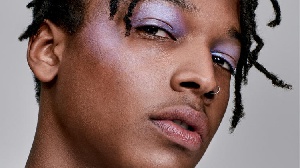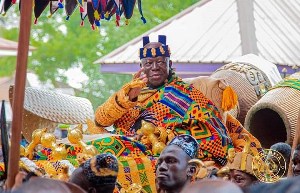- Home - News
- TWI News | TV
- Polls
- Year In Review
- News Archive
- Crime & Punishment
- Politics
- Regional
- Editorial
- Health
- Ghanaians Abroad
- Tabloid
- Africa
- Religion
- Election 2020
- Coronavirus
- News Videos | TV
- Photo Archives
- News Headlines
- Press Release
Opinions of Thursday, 20 October 2016
Columnist: Ellen Thomas
Is makeup for men a fad or the future?
By Ellen Thomas
It’s a thing now: Young men are into makeup, and the industry is going where the boys are. Driven by hyper-connected Generation Z’s disinterest in gender identification, beauty brands are looking to market with a gender-neutral approach.
A report this year by J. Walter Thompson’s The Innovation Group found that 56 percent of Generation Z knows someone who goes by the gender-neutral pronouns of “they,” “them,” or “ze.” They are also rejecting the gender binary while shopping for clothes — 44 percent said they only bought clothes restricted for their own gender, and 70 percent support a move toward gender-neutral bathrooms.
“[Gender] matters less than it used to,” said Lucie Greene, worldwide director of the J. Walter Thompson Innovation Group. “If you’re a youth brand, it’s something you need to embrace and understand. It’s this very self-confident, hyper-individual generation who are constructing their identity in fashion and makeup outside of their traditional gender buckets.”
She listed Jaden Smith, who wears nail polish and skirts, as an example, noting that his penchant for accouterments designed for women doesn’t necessarily indicate anything about his sexuality — it’s simply a matter of self-expression, which she said Gen Z is interested in doing “any way they can.” These are not the drag queens of old.
Last week, Cover Girl announced its appointment of 17-year-old makeup artist James Charles as its first male faces. The brand certainly isn’t the first in beauty to address gender neutrality this year — Milk Makeup launched in January with a genderless approach; Anastasia Beverly Hills debuted its Moonchild Glow Kit campaign featuring male models decked out in prismatic highlighter; Sephora teamed with vlogger Patrick Starrr on a collaboration for its Formula X nail polish line, and Giorgio Armani released a range of tinted lip balms “for him/for her” as part of its fall makeup collection.
And it’s just as much a part of the online world, too. Just this week, The New York Times covered “beauty boys” — male vloggers and YouTube stars who showcase their theatrical makeup skills for millions of followers.
Men wearing makeup is not new — Jean Paul Gaultier tried his hand at a makeup line for men in the Eighties — but an acceptance of it in consumer culture is emerging into the mainstream. “This idea of choice, being whoever you want to be — it’s something that is acceptable more and more,” said art director Fabien Baron. “It’s like the gay evolution in the Sixties and the Eighties. It’s the normal continuation of what should have been happening decades ago.”
“It’s something that’s existed for a long time in a clandestine way,” said Debbie Harry of Blondie. “I sort of like things that are undercover and cool, but it’s better that we acknowledge what our possibilities are. We should share that.”
And like many a beauty phenomenon, it has roots in fashion, with designers like Hood by Air, Vaquera and Gypsy Sport sending gender-neutral clothing down the runway, and powerhouse brands like Burberry and Gucci casting female models in its men’s wear shows.
Gender issues have dominated the recent political and cultural climate as well, from Facebook introducing 56 new gender options in 2014, to Caitlyn Jenner’s highly publicized transformation from male to female last year, and Target’s implementation of a gender-neutral bathroom policy.
Edward Bess, himself a Millennial and founder of a self-named beauty brand sold at Bergdorf Goodman, echoed the sentiment that gender neutrality in beauty is a label issue, not to be confused with a sexuality issue, and noted that the younger generations, so used to being connected to what’s going on in the world via social media, are throwing off traditional societal constraints.
“We’re more and more disinterested in the boring confinement of labels,” said Bess, who just launched Genre, a fragrance designed to be androgynous. And it’s not just the traditional “man” and woman” labels that the younger generation is opposed to. “The term ‘metrosexual’ has fallen out of fashion,” Bess said. “A guy can wear bronzer now and not be labeled.”
Added Greene, “We’re in a state of flux with gender identity and sexuality and how they interplay.”
Mazdack Rassi, founder of Milk Makeup, formulated his makeup and skin-care line with an ethos inspired by the young downtown New York crowd hanging out and working at Milk Studios. Rassi’s products are designed to be up for interpretation as to who can wear them and how they can be used. “We look at our products as paint, as fun,” Rassi said. “We want to take the seriousness out of it.
“The idea is to make it a moot point,” he said of gender. For Milk’s initial campaigns, Rassi purposefully obscured the gender of some of his models. “We have boys who used to be girls or ‘you may look at a girl and think she’s a boy,’” Rassi said. “It’s taking the labels off. This new generation doesn’t think it should be a topic, so it’s not worth bringing up. We want to concentrate on the people and the beauty there and what the product helps them do in life.”
“It was always important to include males in our beauty campaigns, and I’ll do it in the future,” said Claudia Soare, president of Anastasia Beverly Hills. Soare grew up in the beauty industry and said she has always known men who wear makeup, particularly her mother’s makeup artist friends — and many Anastasia customers in fact, are men. For Soare, the Moonchild campaign, as well as an eyeliner campaign in which the brand featured male models, were simply ways to access her customer base. “It was important to speak to them directly.”
For beauty brands that have historically addressed only women, the pressure to market to men is on, but it requires a tactful approach — brands can run the risk of being seen as just riding the wave of whatever is being discussed in the zeitgeist.
“Brands are being called out [now] because they don’t reference things in a respectful way,” said Greene, noting the backlash to the dreadlocks used at Marc Jacobs’s spring show as an example. “The important thing to bear in mind is it can’t seem inauthentic and fetishistic or some kind of appropriation because this [generation] is highly politicized and see through that if it’s not executed very well.”
“In some ways it’s a validation for ‘everyone included’ and the other is a very bold flat-faced marketing initiative to show Cover Girl as edgy and relevant,” said Wendy Liebmann, chief executive officer of WSL Strategic Retail, of Cover Girl’s James Charles announcement. She noted that Cover Girl’s positioning of James Charles as its first male Cover Girl is in line with its diverse brand ambassador appointments in the past, like Ellen DeGeneres and Queen Latifah.
“It’s certainly more culturally relevant than ever,” said Laura Brinker, vice president of influencer marketing at Coty. “It’s a culture of self-expression regardless of gender that has been fueled by social media. As a mass brand, you can be very broadly appealing, so it’s important that we’re at the forefront of those shifts so we can send a message to the beauty industry that this is the way we believe our business and brands are evolving.”
Liebmann stressed caution in executing gender neutral marketing strategies. “It’s that balance between inclusiveness and legitimacy, that it doesn’t feel like it’s too commercial, that’s grounded in authenticity,” Liebmann said.
“Avoid tokenism,” warned one industry source.
Soare advised against “doing something for the shock value or to seem inclusive.” “You risk some backlash from your customer and you risk insulting people by using their lifestyle as an ad campaign,” Soare said. “Be aware of what’s authentic to your customer — if your brand caters to men so much so that you feel the need to acknowledge them in ad campaigns, you should.”
Sam Cheow, chief product accelerator at L’Oréal, pointed out that the company already to markets to men in a subtle way, noting its “beauty for all” motto, and is preparing for a societal shift toward gender progressiveness with new product developments and communications — some of which have already manifested, such as the Armani lip-care range.
He noted two trends percolating in product development. One is uniformization, which means having a genderless positioning, and making products like lip balms that appeals to everyone or fragrance that is unisex in its scent and packaging.
He also pointed to hyper-specialization of products, or offering special types of coverage for different skin types. “The skin of a man is different [than a woman’s] and we need to start considering how we can ensure the coverage they need,” Cheow said. He noted that issues such as hair removal for males transitioning to females, differences in skin texture and coverage needed will pave the way for new niche categories in makeup. “In the next three to five years, there could be some really interesting products coming out.”











